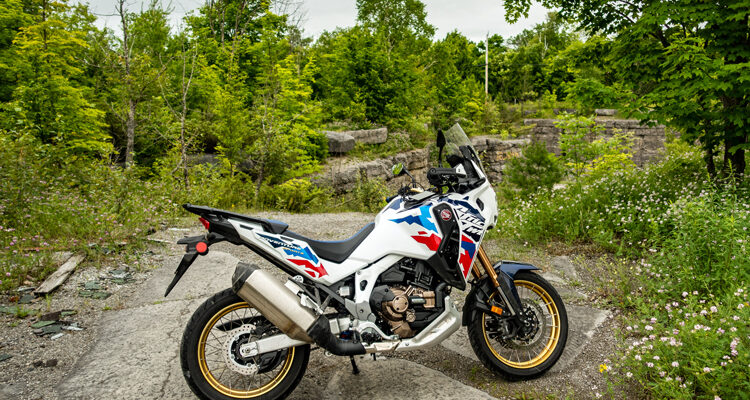When it launched in 2016, the modern Honda Africa Twin (CRF1000) was a shot across the bow to the adventure motorcycle market. The heavyweights of the niche – think BMW’s GS, Ducati’s Mulitstrada, Triumph’s Tiger Explorer – had long been accused of neglecting the off-road riding focus that consumers were now demanding, and the Africa Twin delivered a lighter and livelier middleweight alternative that rode more like a big enduro than a street bike on stilts.
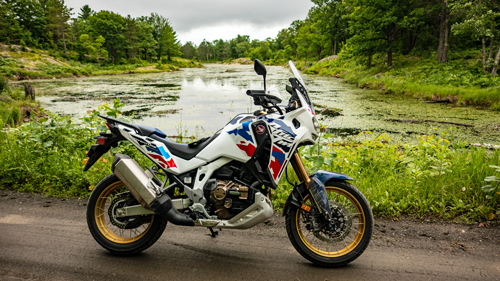
Fast forward a few years and the Africa Twin has evolved; it has added some displacement, a wallop of tech and luxurious niceties. When we rode a base model version a couple of years back, we were happy to report that those additions hadn’t caused it to lose the plot in terms of its raison d’etre. The new 2024 Africa Twin Adventure Sports ES model, however, has been further tweaked this time around to separate itself a little more from its base model sibling. The fairing has been revised to better block the elements and deliver a brawnier look and the seat has gained some extra cushion to better coddle over long, mile munching days. Most importantly though, it now has a smaller front wheel and shorter travel suspension to deliver a more on-road focused option. So the question is, has Honda taken a step backwards or has the Adventure Sports trim finally found its place?
The Look: I’ve long held that the Africa Twin is the best looking middleweight adventure bike. Heck, it may be the best looking adventure bike, period. Sure, other riders may feel the siren song of nostalgia that Husqvarna, Ducati and MV Agusta dealers are singing, but the beakless, twin headlight front end and purposeful, muscular stance combine just enough modern with their retro for the Honda to stand tall.
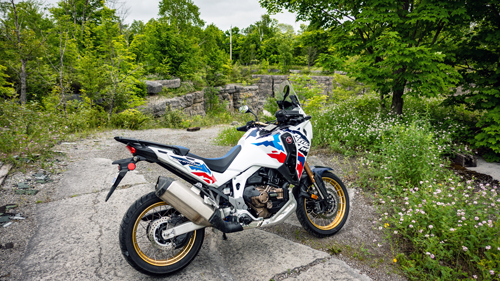
In Adventure Sports ES trim the larger, reshaped fairing adds a touch of muscle to the front end, but I’d be lying if I said it made much of a difference to my overall impression. What truly sets the Adventure Sports ES model apart (and always has) is the Honda HRC (Honda Racing Corporation) tri-colour, Pearl White paint job. Coupled with the gold, tubeless, spoked wheels this bike is an absolute stunner. Not twenty minutes after picking up our loaner I had more than a handful of folks sling compliments my way about what a beautiful motorcycle I was riding. So I don’t think I’m alone in my overall assessment – of course it helped that Honda Canada had shined it up so nicely for me.
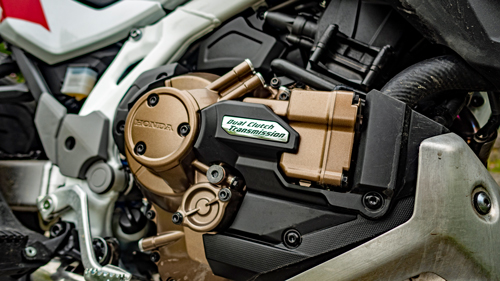
The Sound: Regardless of model, all Africa Twins are powered by Honda’s 1,084 cc, parallel twin engine. The liquid-cooled, single overhead cam, eight-valve engine develops around 100 horsepower and 76 lb-ft of torque. This isn’t exactly category leading when it comes to paper racing in this class of bike, but I don’t think it really needs any additional power as the curve is quite linear and easy to make the most of.
Revisions to the muffler and the airbox – the intake duct is wider and both internal trumpets are longer – also add to the orchestra. Equally important is the use of a 270-degree crankshaft which creates an unequal firing interval that delivers a soundtrack closer resembling a V-Twin’s rumble. At mid throttle, the Twin’s thrum alone is enough to egg you on to faster speeds, so you give it a twist and the Exhaust Control Valve (similar to the set up used in Honda’s repli-racer CBR1000) opens up and the booster squad starts to really cheer.
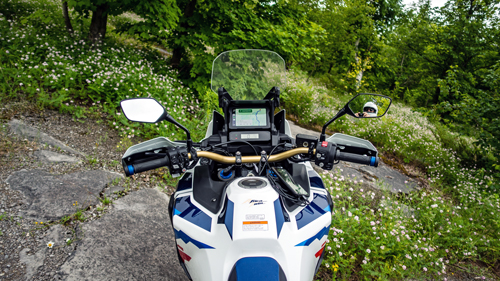
The Africa Twin Adventure Sports ES model we tested came equipped with Honda’s six-speed, Dual Clutch Transmission (DCT). The DCT option means you get no clutch lever for your south-paw to play with as gear shifts are handled in-house. There is both a normal (AT Drive) and sport (AT Sport) mode that alters the automatic transmission’s behaviour – normal will have you slipping up through the gears as quickly as possible to deliver an economical ride, while sport mode holds the gears to help max out power and performance. There is also a manual (AT Manual) mode, where a couple of quick shifting toggles on the left handlebar can be tapped to slot the cog of your choice. You don’t need to be in manual mode to use them though, as they’re ready to go at any time, just know that if you’re not in manual mode the transmission will eventually default back to its automatic setting.
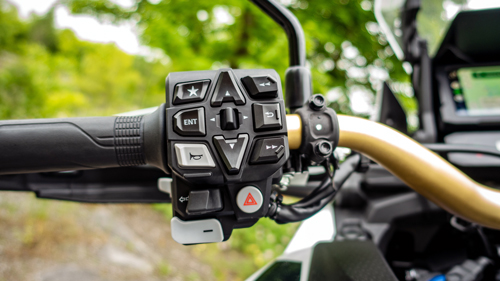
Even if you’ve never driven a car with a DCT (or similar type setup) it is an incredibly intuitive gearbox to get along with. In my years of exposure to it, Honda has continually refined the algorithms that govern the internals, and it continues to get better, regardless of situation or terrain. It really is to the point now where even us dyed-in-the-wool, #savethemanuals flag waving types could be swayed to land one in our garage. Hopping back onto my own bike at the end of a two-week stint with this one, clutching in at a stop light felt like a chore I no longer wished to perform.
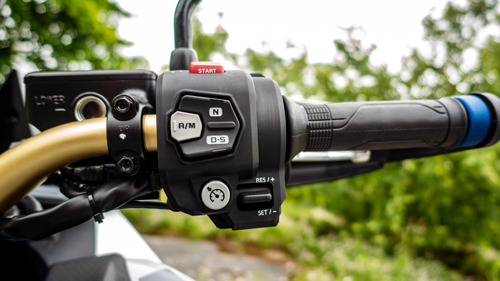
The Feel: In the saddle of the Africa Twin Adventure Sports ES, riders are treated to a firm yet comfortable seat, an easy reach to the wide bars and a surprisingly short stretch to the pegs. I rode the Africa Twin right after having Honda’s smaller Transalp for a couple of weeks and was surprised to note that the Transalp felt roomier, especially in the knee-bend area, despite being a smaller bike with a lower seat height. Regardless, burning through a full 24.8-litre tank (exclusive to the Adventure Sports model) enroute to some remote location could be tackled with ease.
Wind and weather protection is quite good and the adjustable windscreen can be easily operated while on the move. The additional aero that the Adventure Sports ES trim receives helps keep you a bit drier in the rain, but as with all bikes riding gear choice is the ultimate decider in crummy conditions.
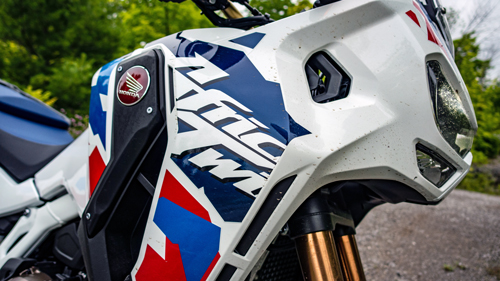
All Africa Twins come equipped with a full suite of safety options (traction control, wheelie control, engine braking, ABS etc.) that are governed by a six-axis inertial measurement unit (IMU). There are six riding modes available (two of which are fully user programmable) that can be chosen on-the-fly to have the Africa Twin optimized for the conditions you’re riding on. Tour, Urban, Gravel and Off-Road are the baked in settings and there is a noticeable difference in bike behaviour as you experiment with the options. I spent most of my time in Tour (even on the gravel and dirt portions of my rides) and found that the bike was easy to keep reined in when I wanted and could be let loose on a whim. The key benefit to switching over to Gravel or Off-Road was that the rear ABS is disabled to help “steer with the rear”, should your levels of skill and aggression in the dirt demand this brand of fun.
The Adventure Sports ES model also scores a semi-active suspension setup that includes electronically controlled Showa EERA 45mm forks and Pro-Link rear shock. The system actively controls damping, compression and rebound, making adjustments in a mere 15 milliseconds based on information incoming from the bikes safety sensors and the action at the fork.
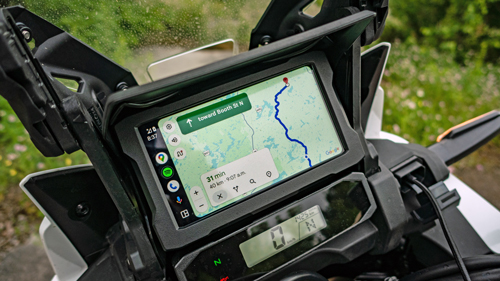
The Tech: One of the features that had me most excited about hopping aboard this new Africa Twin Adventure Sports ES was the integration of Apple CarPlay and Android Auto into its main, 6.5-inch TFT display. Honda is currently the only motorcycle manufacturer to boast this feature and I applaud them for not following every other OEM into the realm of trying to reinvent the wheel when it comes to infotainment and mobile phone integration.
Working from a collection of downloaded GPX files (a collection of GPS waypoints) that the fine folks at Ride The Highlands had assembled, I was able to load up and broadcast one of their new adventure routes onto the Africa Twin’s dash. The system will also pair with your headset communications device so that you still get turn-by-turn directions in your ears and you can still listen to your music/podcast on the ride. Even better, full control of things can be handled by the various buttons on the Africa Twin’s handlebars. All of that worked fabulously with my Pixel 6… for about 45 minutes.
The system only functions with a tethered connection to your phone and Honda recommends that you use the USB charging cable that your phone came with. The only issue is that the connection port to the bike is a USB A interface (those big rectangular ones) and the cable that Google ships with the Pixel is a USB C, so that cable couldn’t work. Swapping over to an aftermarket one that met the physical requirements gave me my intermittent results. It was a highly frustrating experience to say the least, as when things “disconnect” you also lose the audio in your headset, so it’s not just a case of following audible directions – you have to stop, reconfigure and hope for the best.
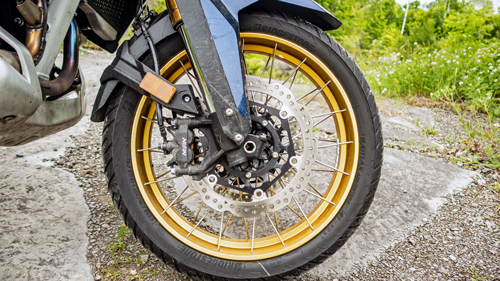
I’m happy to report that my iPhone 12 didn’t suffer the same fate and worked flawlessly. I assume this is because it shipped with a USB A to Lightning Charge cable, but can’t say for sure. My plea to Honda is to simply make the connection a wireless affair, because when it works, it is a game changing experience that would be enough to sway riders away from other competitors.
The Ride: The move to a smaller front wheel on the Africa Twin Adventure Sports ES model makes this bike behave in a much more nimble fashion. It’s not that the normal Africa Twin is a slouch in corners, but that smaller hoop and the revised geometry that it creates translates into a bike that feels happier to be flogged on a winding road. Toggled over to AT Sport, the DCT behaved almost exactly as I would have orchestrated things, holding and swapping cogs at the optimal moment. The engine continues to be an absolute beast, despite being “underpowered” in comparison to its direct competition, and is as fun to listen to as it is to ride when being flogged.
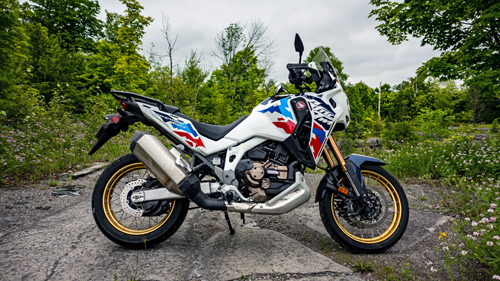
Best of all, depending on the type of off-road riding you have in mind, the Adventure Sports ES won’t hinder things when the tarmac disappears. I will grant that I wasn’t tackling anything bordering on the realm of impossible nor trying to hop over any downed trees along a route. For off-road extremists, the 21-inch front is typically a must have but if that describes you the lighter (cheaper) and so-equipped standard Africa Twin will serve you well. For the rest of us, looking for a comfortable, capable and extremely well-equipped adventure touring mount, the Adventure Sports ES is a great tool for the job.
My only gripes with the overall experience of the Africa Twin Adventure Sports ES lie with my wonky Android Auto experience (which could easily have been more of an issue with my equipment than Honda’s) and its price. At just north of $23k the Adventure Sports ES commands nearly $5k more than the standard Africa Twin (and almost $10k more than the Transalp!!). Sure, it boasts some added niceties, but I feel like an entry-level version with the normal AT’s manually adjustable suspension might be the sweet spot for a wider audience.



